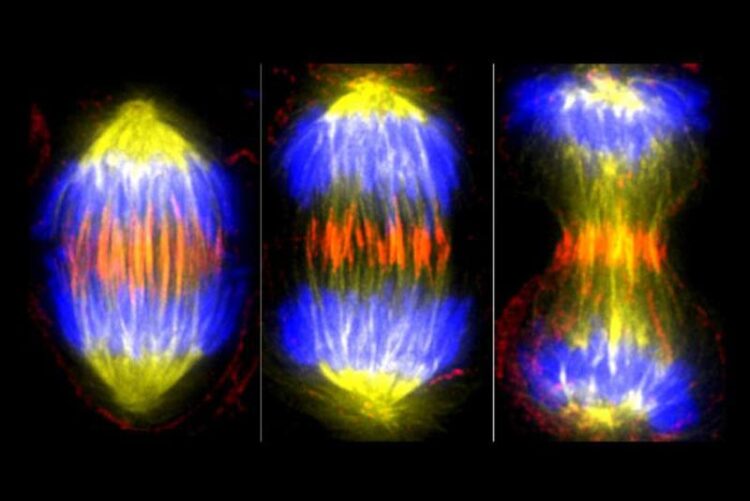The mechanics of mitosis to combat cancer

This image shows a cell in early anaphase, followed by a cell in late anaphase, and one in cytokinesis. These cells were fixed and stained for microtubules (yellow), PRC1 (red), and DNA (blue).
Credit: Rensselaer Polytechnic Institute
Scott Forth receives $1.6 million grant to explore how chromosomes are segregated during cell division.
It is a scary fact that one in two women and one in three men in the United States will develop some form of cancer in their lifetime. One of the hallmarks of many cancers is the occurrence of errors during the cell division process called mitosis. Therefore, critical to enhancing treatments or perhaps even finding a cure for cancer and other diseases, is developing a better understanding of how mitosis works in both healthy and diseased cells.
Rensselaer Polytechnic Institute’s Scott Forth, Ph.D., assistant professor of biological sciences and member of the Shirley Ann Jackson, Ph.D. Center for Biotechnology and Interdisciplinary Studies, has made understanding the cell’s complicated mechanical tasks, such as those needed for mitosis, his life’s work. Recently, he was awarded a $1.6 million grant over five years by the National Institutes of Health to further his research.
With this grant, Forth will explore the mechanical code that underlies the assembly and function of force-generating cytoskeletal networks, using mitosis as a model biological process. One way that cells prepare to divide into two is by duplicating their contents, including chromosomes. Cells then assemble their cytoskeletal networks to produce forces that physically segregate chromosomes into each of two new cells. Errors in this process are linked to cancer.
“Though decades of research has identified a majority of the biological ‘parts’ that are involved, we still do not understand the mechanical rules that dictate how all of these tiny individual pieces work together as ensembles to accomplish goals like the reliable segregation of DNA into two new daughter cells,” said Forth.
Within the cytoskeleton are micron-scale microtubule networks that need both motor and non-motor proteins to move and organize filaments into proper, functional mechanical units that produce the forces needed to pull chromosomes apart. To better understand how they work, Forth will employ a variety of techniques such as biochemical reconstitution, single-molecule fluorescence microscopy, optical trapping, and live-cell imaging. Biochemical reconstitution employs purified proteins to mimic intracellular processes outside of the cell, and optical trapping is a method for measuring the tiny forces that proteins can generate. Fluorescence microscopy will be used at the same time to watch individual molecules respond to these forces, while live cell imaging will be performed to confirm these biophysical measurements in real dividing cells.
With this grant, Forth hopes to gain three new insights. First, his lab will determine the mechanical and functional differences between bridging fibers in metaphase, when chromosomes are first being properly centered within the cell, and the central spindle microtubule network in anaphase, when chromosomes are being pulled away from each other. Second, he will determine the molecular mechanisms that regulate how microtubule-associated proteins (MAPs) cluster to form novel cellular “building blocks,” and decipher the functional role of MAP clusters in regulating microtubule organization. Third, his lab will determine how complexes of motor and non-motor MAPs collectively regulate microtubule organization during later stages of mitosis to help ensure proper division of the two cells.
“Dr. Forth’s work in cellular physics informs our understanding of diseases, such as cancer, that occur when cell structures fail,” said Curt Breneman, Ph.D., dean of Rensselaer’s School of Science. “With this grant, Dr. Forth will gain new insights into molecular mysteries that may forge a path to the development of new diagnostics and treatments.”
About Rensselaer Polytechnic Institute:
Founded in 1824, Rensselaer Polytechnic Institute is America’s first technological research university. Rensselaer encompasses five schools, over 30 research centers, more than 140 academic programs including 25 new programs, and a dynamic community made up of over 6,800 students and 110,000 living alumni. Rensselaer faculty and alumni include upwards of 155 National Academy members, six members of the National Inventors Hall of Fame, six National Medal of Technology winners, five National Medal of Science winners, and a Nobel Prize winner in Physics. With nearly 200 years of experience advancing scientific and technological knowledge, Rensselaer remains focused on addressing global challenges with a spirit of ingenuity and collaboration. To learn more, please visit www.rpi.edu.
Contact:
Katie Malatino
Sr. Communications Specialist
malatk@rpi.edu
838-240-5691
For general inquiries: newsmedia@rpi.edu
Visit the Rensselaer research and discovery blog: https://everydaymatters.rpi.edu/
Follow us on Twitter: @RPINews
Media Contact
Katie Malatino
Rensselaer Polytechnic Institute
malatk@rpi.edu
Cell: 838-240-5691
All latest news from the category: Awards Funding
Newest articles

Innovative 3D printed scaffolds offer new hope for bone healing
Researchers at the Institute for Bioengineering of Catalonia have developed novel 3D printed PLA-CaP scaffolds that promote blood vessel formation, ensuring better healing and regeneration of bone tissue. Bone is…

The surprising role of gut infection in Alzheimer’s disease
ASU- and Banner Alzheimer’s Institute-led study implicates link between a common virus and the disease, which travels from the gut to the brain and may be a target for antiviral…

Molecular gardening: New enzymes discovered for protein modification pruning
How deubiquitinases USP53 and USP54 cleave long polyubiquitin chains and how the former is linked to liver disease in children. Deubiquitinases (DUBs) are enzymes used by cells to trim protein…



